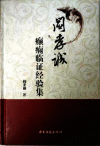Analysis of Medication Rule of Primary Epilepsy Based on Xiaocheng Yan's Clinical Experience Collection of Epilepsy
- PMID: 35795265
- PMCID: PMC9252657
- DOI: 10.1155/2022/9539944
Analysis of Medication Rule of Primary Epilepsy Based on Xiaocheng Yan's Clinical Experience Collection of Epilepsy
Abstract
Objective: To explore and analyze the medication rule of Professor Xiaocheng Yan in the treatment of primary epilepsy, hoping to provide reference for the clinical treatment of primary epilepsy.
Methods: Mining and analysis of Professor Xiaocheng Yan sorted out the medical cases of primary epilepsy in Xiaocheng Yan's clinical experience collection of epilepsy, extracted the traditional Chinese medicine (TCM) prescription data in the medical cases, standardized the obtained TCM prescription data, and used the data mining function integrated by the ancient and modern medical case cloud platform V2.3.5 to carry out frequency statistics, cluster analysis, association analysis, and complex network analysis on the TCM data, and the common herbs used by Professor Xiaocheng Yan in the treatment of primary epilepsy, properties and classifications of commonly used herbs, pairs of commonly used herbs, and core prescriptions were obtained.
Results: A total of 39 cases, 228 medical records, and 230 prescriptions data of TCM were included. A total of 96 Chinese medicinal herbs were involved, and the total frequency of medication was 3,828. High-frequency herbs include Rhizoma Gastrodiae (Tianma) (222 times), Ramulus Uncariae cum Uncis (Gouteng) (220 times), Rhizoma Acori Tatarinowii (Shichangpu) (216 times), Rhizoma Pinelliae Praeparatum (Fabanxia) (207 times), Bombyx Batryticatus (Jiangcan) (206 times), and Periostracum Cicadae (Chantui) (181 times). The main properties and flavors of commonly used Chinese medicinal herbs were sweet, bitter, and pungent, which were mainly attributed to the four meridians of liver, lung, heart, and spleen. Commonly used couplet herbs were {Periostracum Cicadae (Chantui)} ≥ {Bombyx Batryticatus (Jiangcan)}, {Rhizoma Acori Tatarinowii (Shichangpu)} ≥{ Bombyx Batryticatus (Jiangcan)}, {Radix Bupleuri (Chaihu)} ≥ {Radix Scutellariae (Huangqin)}, {Rhizoma Gastrodiae (Tianma)} ≥ {Ramulus Uncariae cum Uncis (Gouteng)}, {Rhizoma Acori Tatarinowii (Shichangpu)} ≥ {Periostracum Cicadae (Chantui)}, {Ramulus Uncariae cum Uncis (Gouteng)} ≥ {Bombyx Batryticatus (Jiangcan)}, {Bombyx Batryticatus (Jiangcan)} ≥ {Rhizoma Gastrodiae (Tianma)}, {Rhizoma Acori Tatarinowii (Shichangpu)} ≥ {Ramulus Uncariae cum Uncis (Gouteng)}, etc. The core prescription composition was based on the addition and subtraction of Tianma Gouteng decoction and Erchen decoction. The main pharmacological mechanisms of core prescriptions are mainly reflected in antioxidation, enhancing GABA efficacy, and regulating NMDA channel and sodium channel, neuroprotection, and so on.
Conclusion: Professor Xiaocheng Yan's medication for the treatment of primary epilepsy was based on the principle of relieving wind and spasm, drying dampness and resolving phlegm, giving consideration to both Qi and blood, and harmonizing liver, lung, heart, and spleen.
Copyright © 2022 Yu Zhang et al.
Conflict of interest statement
The authors declared that there are no conflicts of interest regarding the publication of this article.
Figures







Similar articles
-
Effects of Tianma (Rhizoma Gastrodiae) and Gouteng (Ramulus Uncariae Rhynchophyllae cum Uncis) on cytochrome P450 enzyme activities in rats.J Tradit Chin Med. 2021 Apr;41(2):284-292. J Tradit Chin Med. 2021. PMID: 33825409
-
[Data mining-based analysis of formulation rules for prescriptions containing herbal pair Acori Tatarinowii Rhizoma-Polygalae Radix].Zhongguo Zhong Yao Za Zhi. 2022 Mar;47(6):1687-1693. doi: 10.19540/j.cnki.cjcmm.20211203.502. Zhongguo Zhong Yao Za Zhi. 2022. PMID: 35347968 Chinese.
-
[Medication rules of Chinese herbs in treatment of H-type hypertension based on data mining].Zhongguo Zhong Yao Za Zhi. 2024 May;49(9):2522-2531. doi: 10.19540/j.cnki.cjcmm.20240117.501. Zhongguo Zhong Yao Za Zhi. 2024. PMID: 38812148 Chinese.
-
Review on the characteristics of liver-pacifying medicinal in relation to the treatment of stroke: from scientific evidence to traditional medical theory.J Tradit Chin Med. 2018 Feb;38(1):139-150. J Tradit Chin Med. 2018. PMID: 32185963 Review.
-
A Data Mining-Based Study on Medication Rules of Chinese Herbs to Treat Heart Failure with Preserved Ejection Fraction.Chin J Integr Med. 2022 Sep;28(9):847-854. doi: 10.1007/s11655-022-2892-5. Epub 2022 Jul 12. Chin J Integr Med. 2022. PMID: 35829954 Review.
Cited by
-
Acori Tatarinowii Rhizoma: A comprehensive review of its chemical composition, pharmacology, pharmacokinetics and toxicity.Front Pharmacol. 2023 Mar 16;14:1090526. doi: 10.3389/fphar.2023.1090526. eCollection 2023. Front Pharmacol. 2023. PMID: 37007031 Free PMC article. Review.
-
Use of Integrative, Complementary, and Alternative Medicine in Children with Epilepsy: A Global Scoping Review.Children (Basel). 2023 Apr 12;10(4):713. doi: 10.3390/children10040713. Children (Basel). 2023. PMID: 37189961 Free PMC article.
References
-
- Chinese Medical Association. Clinical Guidelines For Diagnosis and Treatment of Epilepsy . Beijing, China: People’s Health Publishing House; 2018.
-
- Miao A. L., Wang X. S. Diagnosis and treatment of epilepsy. Journal of Clinical Medicine . 2013;13(12):797–799.
-
- Jia J. P., Chen S. D. Neurology . Beijing, China: People’s Health Publishing House; 2013.
-
- Yang Y. F., Xia L. B. Diagnosis and Treatment of Epilepsy . Taiyuan, China: Shanxi Science and Technology Press; 1997.
LinkOut - more resources
Full Text Sources

